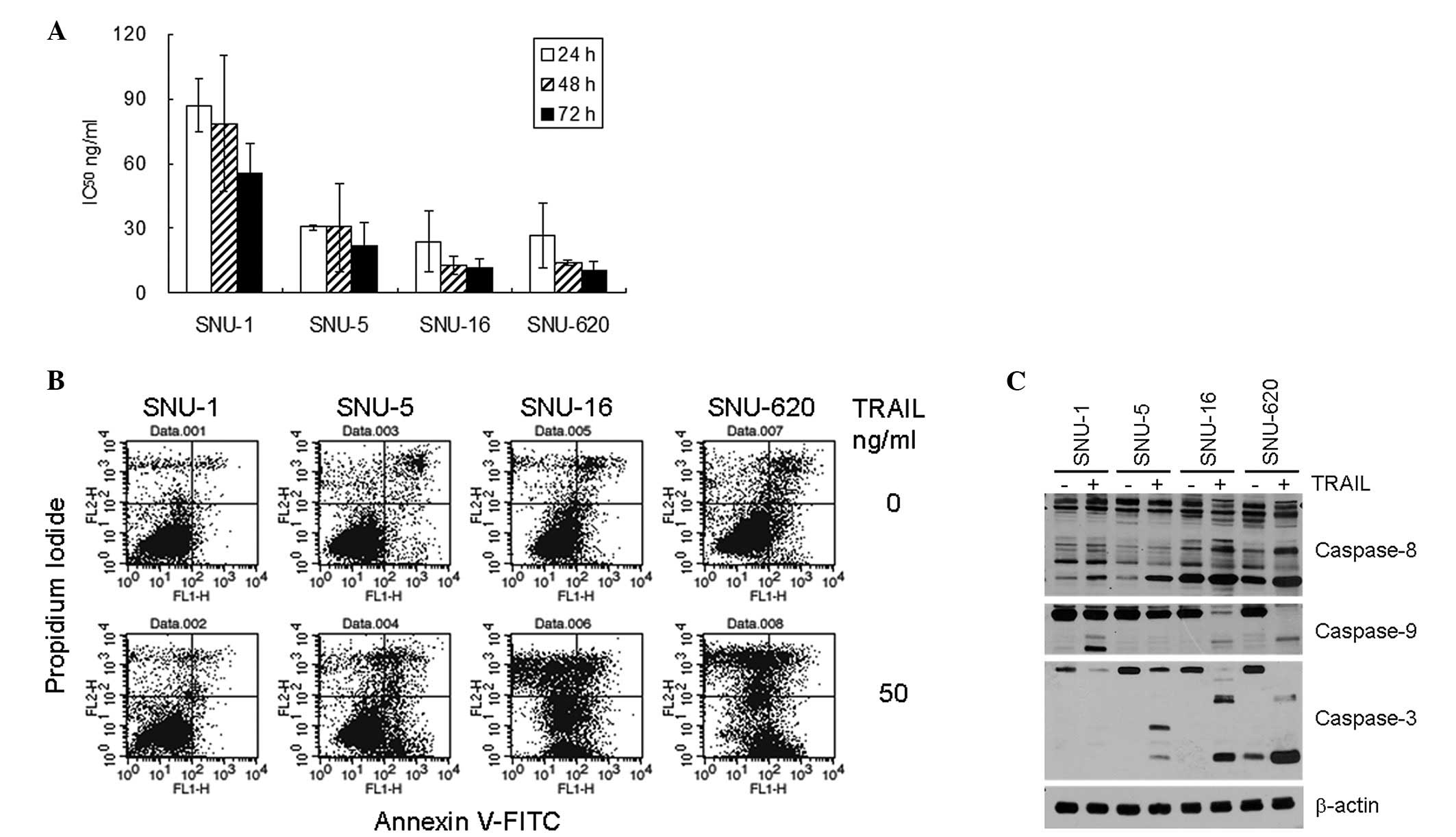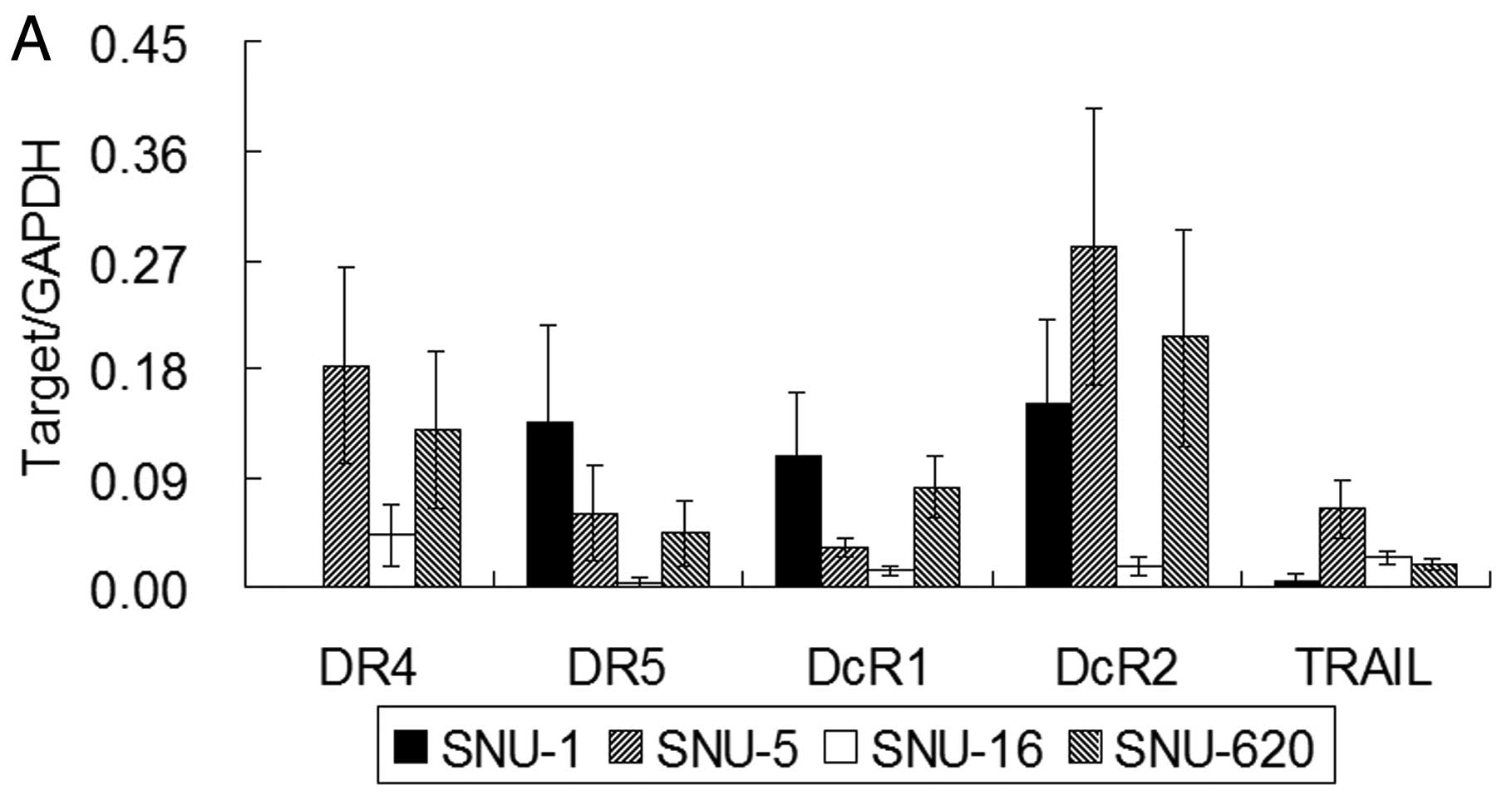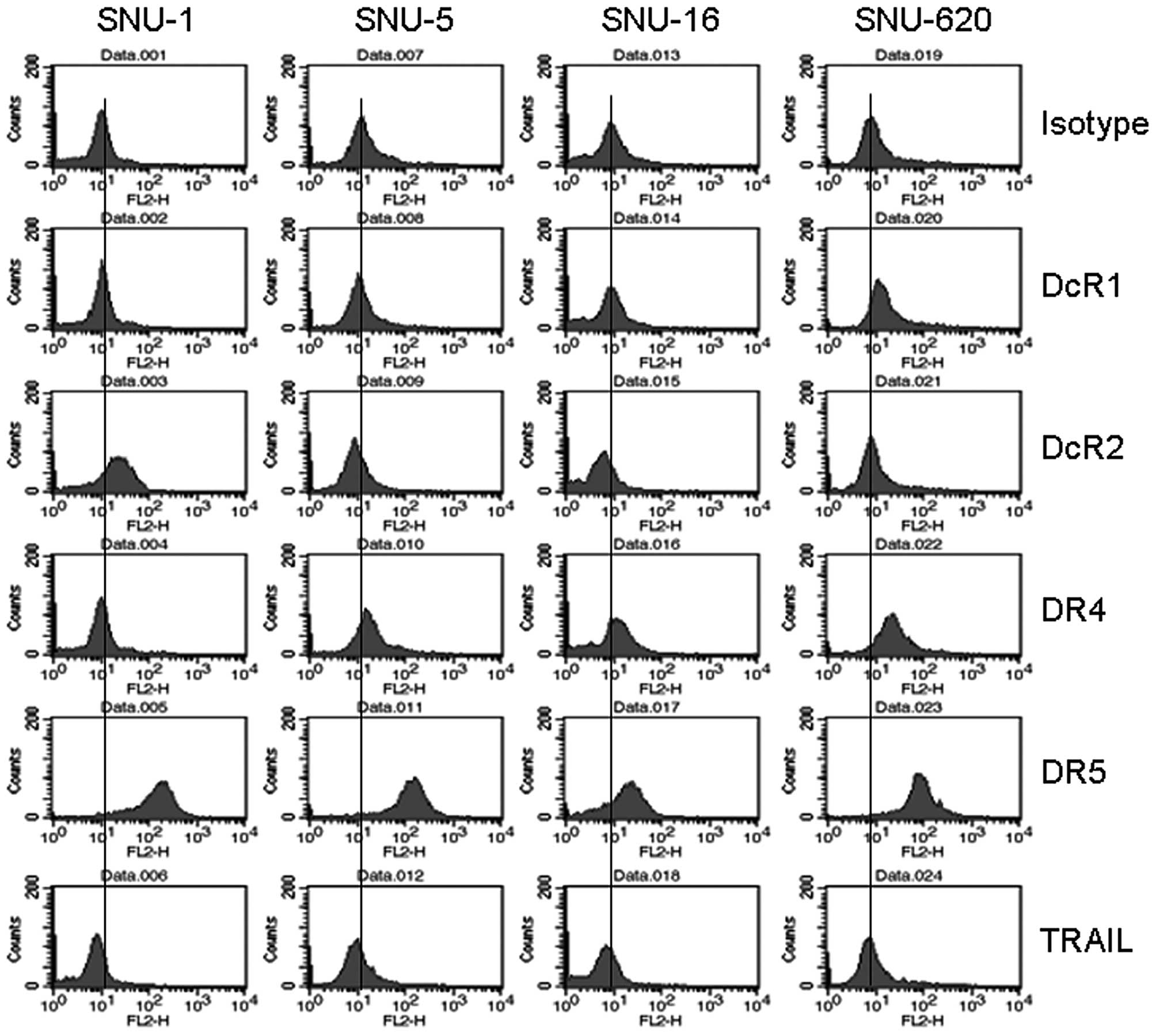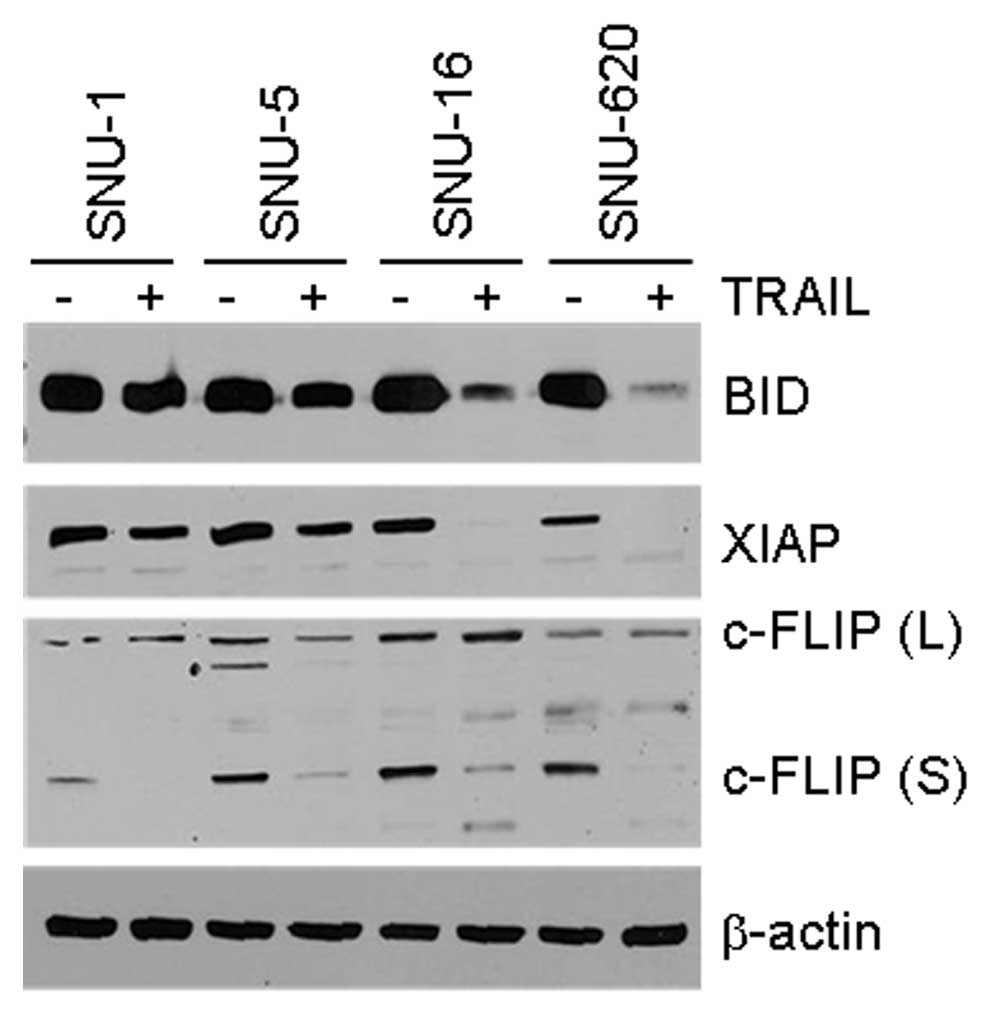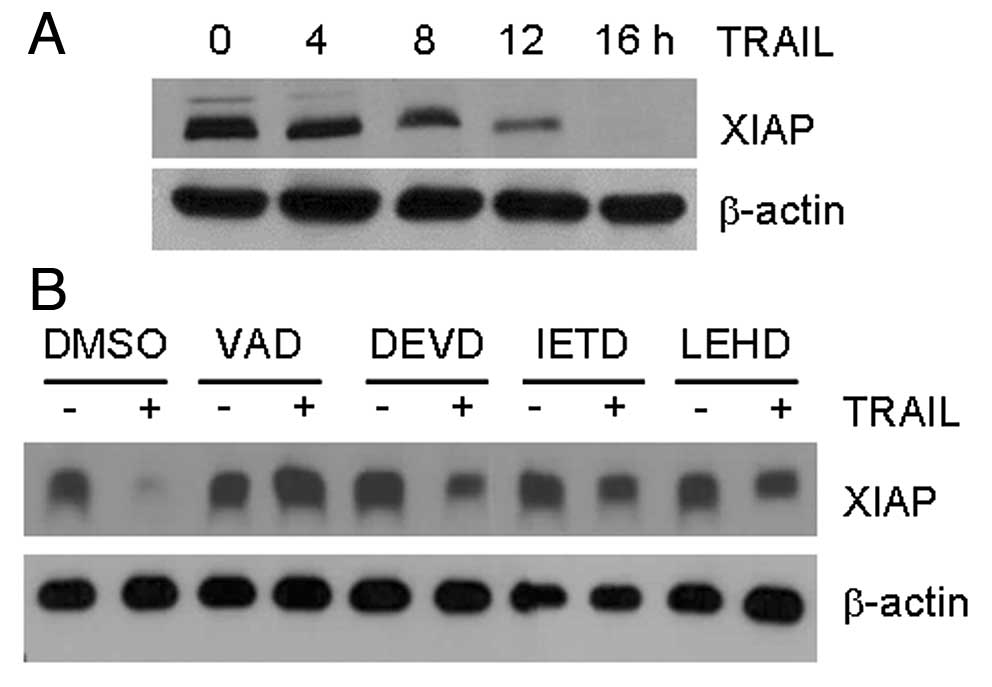|
1
|
Wiley SR, Schooley K, Smolak PJ, et al:
Identification and characterization of a new member of the TNF
family that induces apoptosis. Immunity. 3:673–682. 1995.
View Article : Google Scholar : PubMed/NCBI
|
|
2
|
Bouralexis S, Findlay DM and Evdokiou A:
Death to the bad guys: targeting cancer via Apo2L/TRAIL. Apoptosis.
10:35–51. 2005. View Article : Google Scholar : PubMed/NCBI
|
|
3
|
Simonet WS, Lacey DL, Dunstan CR, et al:
Osteoprotegerin: a novel secreted protein involved in the
regulation of bone density. Cell. 89:309–319. 1997. View Article : Google Scholar : PubMed/NCBI
|
|
4
|
Almasan A and Ashkenazi A: Apo2L/TRAIL:
apoptosis signaling, biology, and potential for cancer therapy.
Cytokine Growth Factor Rev. 14:337–348. 2003. View Article : Google Scholar : PubMed/NCBI
|
|
5
|
Zauli G and Secchiero P: The role of the
TRAIL/TRAIL receptors system in hematopoiesis and endothelial cell
biology. Cytokine Growth Factor Rev. 17:245–257. 2006. View Article : Google Scholar : PubMed/NCBI
|
|
6
|
Ashkenazi A, Pai RC, Fong S, et al: Safety
and antitumor activity of recombinant soluble Apo2 ligand. J Clin
Invest. 104:155–162. 1999. View
Article : Google Scholar : PubMed/NCBI
|
|
7
|
Xiang H, nguyen CB, Kelley SK, Dybdal N
and Escandon E: Tissue distribution, stability, and
pharmacokinetics of Apo2 ligand/tumor necrosis factor-related
apoptosis-inducing ligand in human colon carcinoma COLO205
tumor-bearing nude mice. Drug Metab Dispos. 32:1230–1238. 2004.
View Article : Google Scholar
|
|
8
|
Johnstone RW, Frew AJ and Smyth MJ: The
TRAIL apoptotic pathway in cancer onset, progression and therapy.
Nat Rev Cancer. 8:782–798. 2008. View
Article : Google Scholar : PubMed/NCBI
|
|
9
|
Zhang L and Fang B: Mechanisms of
resistance to TRAIL-induced apoptosis in cancer. Cancer Gene Ther.
12:228–237. 2005. View Article : Google Scholar : PubMed/NCBI
|
|
10
|
Hopkins-Donaldson S, Ziegler A, Kurtz S,
et al: Silencing of death receptor and caspase-8 expression in
small cell lung carcinoma cell lines and tumors by DNA methylation.
Cell Death Differ. 10:356–364. 2003. View Article : Google Scholar : PubMed/NCBI
|
|
11
|
Kim K, Fisher MJ, Xu SQ and el-Deiry WS:
Molecular determinants of response to TRAIL in killing of normal
and cancer cells. Clin Cancer Res. 6:335–346. 2000.PubMed/NCBI
|
|
12
|
Ozoren N, Fisher MJ, Kim K, et al:
Homozygous deletion of the death receptor DR4 gene in a
nasopharyngeal cancer cell line is associated with TRAIL
resistance. Int J Oncol. 16:917–925. 2000.PubMed/NCBI
|
|
13
|
Wajant H, Pfizenmaier K and Scheurich P:
TNF-related apoptosis inducing ligand (TRAIL) and its receptors in
tumor surveillance and cancer therapy. Apoptosis. 7:449–459. 2002.
View Article : Google Scholar : PubMed/NCBI
|
|
14
|
Sanlioglu AD, Dirice E, Aydin C, Erin N,
Koksoy S and Sanlioglu S: Surface TRAIL decoy receptor-4 expression
is correlated with TRAIL resistance in MCF7 breast cancer cells.
BMC Cancer. 5:542005. View Article : Google Scholar : PubMed/NCBI
|
|
15
|
Cummins JM, Kohli M, Rago C, Kinzler KW,
Vogelstein B and Bunz F: X-linked inhibitor of apoptosis protein
(XIAP) is a nonredundant modulator of tumor necrosis factor-related
apoptosis-inducing ligand (TRAIL)-mediated apoptosis in human
cancer cells. Cancer Res. 64:3006–3008. 2004. View Article : Google Scholar
|
|
16
|
Nam SY, Jung GA, Hur GC, et al:
Upregulation of FLIP(S) by Akt, a possible inhibition mechanism of
TRAIL-induced apoptosis in human gastric cancers. Cancer Sci.
94:1066–1073. 2003. View Article : Google Scholar : PubMed/NCBI
|
|
17
|
Sun SY, Yue P, Zhou JY, et al:
Overexpression of Bcl2 blocks TNF-related apoptosis-inducing ligand
(TRAIL)-induced apoptosis in human lung cancer cells. Biochem
Biophys Res Commun. 280:788–797. 2001. View Article : Google Scholar : PubMed/NCBI
|
|
18
|
Chen JJ, Knudsen S, Mazin W, Dahlgaard J
and Zhang B: A 71-gene signature of TRAIL sensitivity in cancer
cells. Mol Cancer Ther. 11:34–44. 2012. View Article : Google Scholar : PubMed/NCBI
|
|
19
|
Mahalingam D, Szegezdi E, Keane M, de Jong
S and Samali A: TRAIL receptor signalling and modulation: are we on
the right TRAIL? Cancer Treat Rev. 35:280–288. 2009. View Article : Google Scholar : PubMed/NCBI
|
|
20
|
Ferlay J, Shin HR, Bray F, Forman D,
Mathers C and Parkin DM: Estimates of worldwide burden of cancer in
2008: GLOBOCAN 2008. Int J Cancer. 127:2893–2917. 2010. View Article : Google Scholar : PubMed/NCBI
|
|
21
|
Cervantes A, Rosello S, Roda D and
Rodriguez-Braun E: The treatment of advanced gastric cancer:
current strategies and future perspectives. Ann Oncol. 19(Suppl 5):
v103–v107. 2008. View Article : Google Scholar : PubMed/NCBI
|
|
22
|
Yoong J, Michael M and Leong T: Targeted
therapies for gastric cancer: current status. Drugs. 71:1367–1384.
2011. View Article : Google Scholar : PubMed/NCBI
|
|
23
|
Qiao L and Wong BC: Targeting apoptosis as
an approach for gastrointestinal cancer therapy. Drug Resist Updat.
12:55–64. 2009. View Article : Google Scholar : PubMed/NCBI
|
|
24
|
Belkhiri A, Zhu S, Chen Z, Soutto M and
El-Rifai W: Resistance to TRAIL Is Mediated by DARPP-32 in Gastric
Cancer. Clin Cancer Res. 18:3889–3900. 2012. View Article : Google Scholar : PubMed/NCBI
|
|
25
|
Qu J, Zhao M, Teng Y, et al:
Interferon-alpha sensitizes human gastric cancer cells to
TRAIL-induced apoptosis via activation of the c-CBL-dependent
MAPK/ERK pathway. Cancer Biol Ther. 12:494–502. 2011. View Article : Google Scholar : PubMed/NCBI
|
|
26
|
Liu J, Qu XJ, Xu L, et al: Bortezomib
synergizes TRAIL-induced apoptosis in gastric cancer cells. Dig Dis
Sci. 55:3361–3368. 2010. View Article : Google Scholar : PubMed/NCBI
|
|
27
|
Huynh KM, Soh JW, Dash R, Sarkar D, Fisher
PB and Kang D: FOXM1 expression mediates growth suppression during
terminal differentiation of HO-1 human metastatic melanoma cells. J
Cell Physiol. 226:194–204. 2011. View Article : Google Scholar
|
|
28
|
Uno K, Inukai T, Kayagaki N, et al:
TNF-related apoptosis-inducing ligand (TRAIL) frequently induces
apoptosis in Philadelphia chromosome-positive leukemia cells.
Blood. 101:3658–3667. 2003. View Article : Google Scholar : PubMed/NCBI
|
|
29
|
Hornle M, Peters N, Thayaparasingham B,
Vorsmann H, Kashkar H and Kulms D: Caspase-3 cleaves XIAP in a
positive feedback loop to sensitize melanoma cells to TRAIL-induced
apoptosis. Oncogene. 30:575–587. 2011. View Article : Google Scholar : PubMed/NCBI
|
|
30
|
Park JG, Frucht H, LaRocca RV, et al:
Characteristics of cell lines established from human gastric
carcinoma. Cancer Res. 50:2773–2780. 1990.PubMed/NCBI
|
|
31
|
Park JG, Yang HK, Kim WH, et al:
Establishment and characterization of human gastric carcinoma cell
lines. Int J Cancer. 70:443–449. 1997. View Article : Google Scholar : PubMed/NCBI
|
|
32
|
Koyama S, Koike N and Adachi S: Expression
of TNF-related apoptosis-inducing ligand (TRAIL) and its receptors
in gastric carcinoma and tumor-infiltrating lymphocytes: a possible
mechanism of immune evasion of the tumor. J Cancer Res Clin Oncol.
128:73–79. 2002. View Article : Google Scholar
|
|
33
|
Lee KH, Lim SW, Kim HG, et al: Lack of
death receptor 4 (DR4) expression through gene promoter methylation
in gastric carcinoma. Langenbecks Arch Surg. 394:661–670. 2009.
View Article : Google Scholar : PubMed/NCBI
|
|
34
|
Park WS, Lee JH, Shin MS, et al:
Inactivating mutations of KILLER/DR5 gene in gastric cancers.
Gastroenterology. 121:1219–1225. 2001. View Article : Google Scholar : PubMed/NCBI
|
|
35
|
Fisher MJ, Virmani AK, Wu L, et al:
Nucleotide substitution in the ectodomain of trail receptor DR4 is
associated with lung cancer and head and neck cancer. Clin Cancer
Res. 7:1688–1697. 2001.PubMed/NCBI
|
|
36
|
Lemke J, Noack A, Adam D, et al: TRAIL
signaling is mediated by DR4 in pancreatic tumor cells despite the
expression of functional DR5. J Mol Med. 88:729–740. 2010.
View Article : Google Scholar : PubMed/NCBI
|
|
37
|
Szliszka E, Mazur B, Zydowicz G, Czuba ZP
and Krol W: TRAIL-induced apoptosis and expression of death
receptor TRAIL-R1 and TRAIL-R2 in bladder cancer cells. Folia
Histochem Cytobiol. 47:579–585. 2009.PubMed/NCBI
|
|
38
|
Aggarwal BB, Bhardwaj U and Takada Y:
Regulation of TRAIL-induced apoptosis by ectopic expression of
antiapoptotic factors. Vitam Horm. 67:453–483. 2004. View Article : Google Scholar : PubMed/NCBI
|
|
39
|
Goncharenko-Khaider N, Lane D, Matte I,
Rancourt C and Piche A: The inhibition of Bid expression by Akt
leads to resistance to TRAIL-induced apoptosis in ovarian cancer
cells. Oncogene. 29:5523–5536. 2010. View Article : Google Scholar : PubMed/NCBI
|
|
40
|
Seal S, Hockenbery DM, Spaulding EY, Kiem
HP, Abbassi N and Deeg HJ: Differential responses of FLIPLong and
FLIPShort-overexpressing human myeloid leukemia cells to TNF-alpha
and TRAIL-initiated apoptotic signals. Exp Hematol. 36:1660–1672.
2008. View Article : Google Scholar
|
|
41
|
Zhang XD, Franco A, Myers K, Gray C,
Nguyen T and Hersey P: Relation of TNF-related apoptosis-inducing
ligand (TRAIL) receptor and FLICE-inhibitory protein expression to
TRAIL-induced apoptosis of melanoma. Cancer Res. 59:2747–2753.
1999.PubMed/NCBI
|















